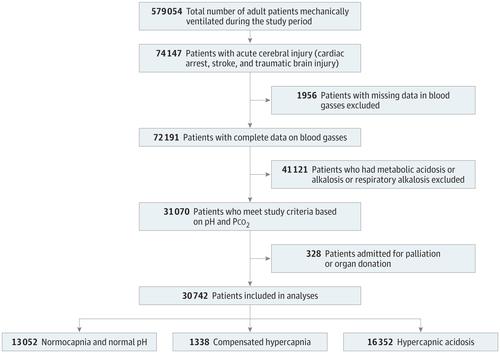JAMA Neurology ( IF 20.4 ) Pub Date : 2018-07-01 , DOI: 10.1001/jamaneurol.2018.0123
Ravindranath Tiruvoipati 1, 2, 3 , David Pilcher 3, 4, 5 , John Botha 1, 2 , Hergen Buscher 6, 7 , Robert Simister 8 , Michael Bailey 3, 4

|
Importance Clinical studies investigating the effects of hypercapnia and hypercapnic acidosis in acute cerebral injury are limited. The studies performed so far have mainly focused on the outcomes in relation to the changes in partial pressure of carbon dioxide and pH in isolation and have not evaluated the effects of partial pressure of carbon dioxide and pH in conjunction.
Objective To review the association of compensated hypercapnia and hypercapnic acidosis during the first 24 hours of intensive care unit admission on hospital mortality in adult mechanically ventilated patients with cerebral injury.
Design, Setting, and Participants Multicenter, binational retrospective review of patients with cerebral injury (traumatic brain injury, cardiac arrest, and stroke) admitted to 167 intensive care units in Australia and New Zealand between January 2000 and December 2015. Patients were classified into 3 groups based on combination of arterial pH and arterial carbon dioxide (normocapnia and normal pH, compensated hypercapnia, and hypercapnic acidosis) during the first 24 hours of intensive care unit stay.
Main Outcomes and Measures Hospital mortality.
Results A total of 30 742 patients (mean age, 55 years; 21 827 men [71%]) were included. Unadjusted hospital mortality rates were highest in patients with hypercapnic acidosis. Multivariable logistic regression analysis and Cox proportional hazards analysis in 3 diagnostic categories showed increased odds of hospital mortality (cardiac arrest odds ratio [OR], 1.51; 95% CI, 1.34-1.71; stroke OR, 1.43; 95% CI, 1.27-1.6; and traumatic brain injury OR, 1.22; 95% CI, 1.06-1.42; P <.001) and hazard ratios (HR) (cardiac arrest HR, 1.23; 95% CI, 1.14-1.34; stroke HR, 1.3; 95% CI, 1.21-1.4; traumatic brain injury HR, 1.13; 95% CI, 1-1.27), in patients with hypercapnic acidosis compared with normocapnia and normal pH. There was no difference in mortality between patients who had compensated hypercapnia compared with patients who had normocapnia and normal pH. In patients with hypercapnic acidosis, the adjusted OR of hospital mortality increased with increasing partial pressure of carbon dioxide, while no such increase was noted in patients with compensated hypercapnia.
Conclusions and Relevance Hypercapnic acidosis was associated with increased risk of hospital mortality in patients with cerebral injury. Hypercapnia, when compensated to normal pH during the first 24 hours of intensive care unit admission, may not be harmful in mechanically ventilated patients with cerebral injury.
中文翻译:

机械通气性脑损伤患者高碳酸血症和高碳酸血症与临床结果的关系
重要性 临床上研究高碳酸血症和高碳酸血症性酸中毒在急性脑损伤中的作用是有限的。迄今为止进行的研究主要集中在与孤立地分离二氧化碳和pH的分压有关的结果上,并且还没有结合评估二氧化碳和pH的分压的影响。
目的 探讨重症监护病房入院后24小时内代偿性高碳酸血症与高碳酸血症性酸中毒与成人机械通气性脑损伤患者住院死亡率的相关性。
设计,设置和参与人 2000年1月至2015年12月在澳大利亚和新西兰的167个重症监护病房接受脑损伤(颅脑外伤,心脏骤停和中风)患者的多中心,双国回顾性回顾研究。患者分为3类在重症监护病房住院的最初24小时内,根据动脉pH和动脉二氧化碳(正常碳酸血症和正常pH,代偿性高碳酸血症和高碳酸血症性酸中毒)的组合进行分组。
主要结果和措施 医院死亡率。
结果 共纳入30 742例患者(平均年龄55岁; 21 827例男性[71%])。高碳酸血症性酸中毒患者未经调整的医院死亡率最高。在3个诊断类别中的多变量logistic回归分析和Cox比例风险分析显示医院死亡几率增加(心脏骤停几率[OR]为1.51; 95%CI为1.34-1.71;中风OR为1.43; 95%CI为1.27-1.6 ;以及脑外伤OR,1.22; 95%CI,1.06-1.42;P <.001)和危险比(HR)(心脏骤停HR,1.23; 95%CI,1.14-1.34;中风HR,1.3; 95%CI,1.21-1.4;外伤性脑损伤HR,1.13; 95%CI,1 -1.27),高碳酸血症性酸中毒的患者与正常碳酸血症和正常pH值相比。代偿性高碳酸血症的患者与正常碳酸血症和正常pH的患者相比,死亡率没有差异。在高碳酸血症性酸中毒患者中,随着二氧化碳分压的升高,医院死亡率调整后的OR值增加,而代偿性高碳酸血症患者则未见这种增加。
结论和相关性 高碳酸血症性酸中毒与脑损伤患者住院死亡风险增加相关。当在重症监护病房入院的最初24小时内将高碳酸血症补偿到正常pH值时,对机械通气的脑损伤患者可能无害。































 京公网安备 11010802027423号
京公网安备 11010802027423号